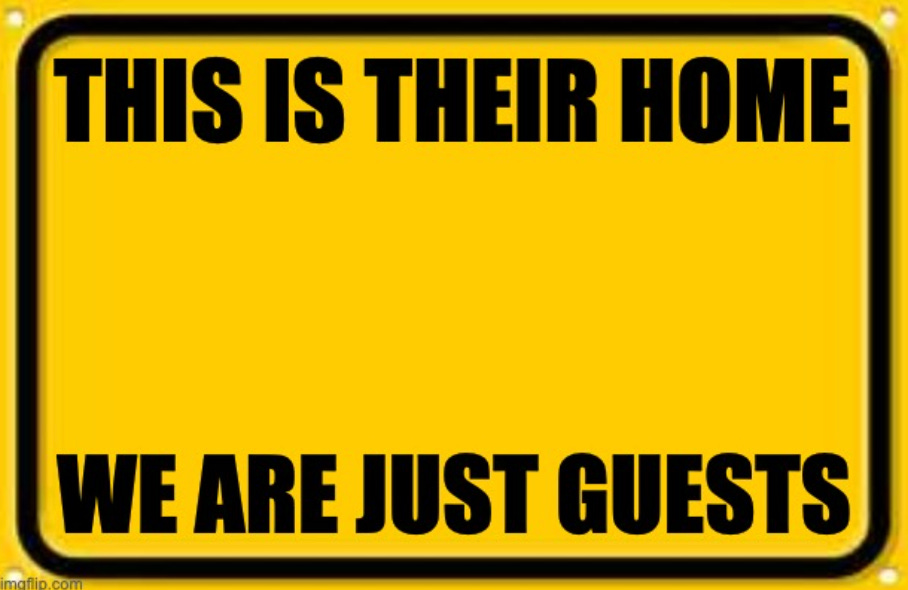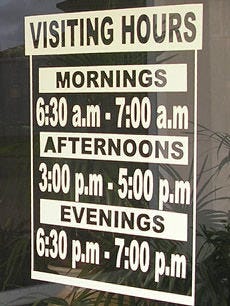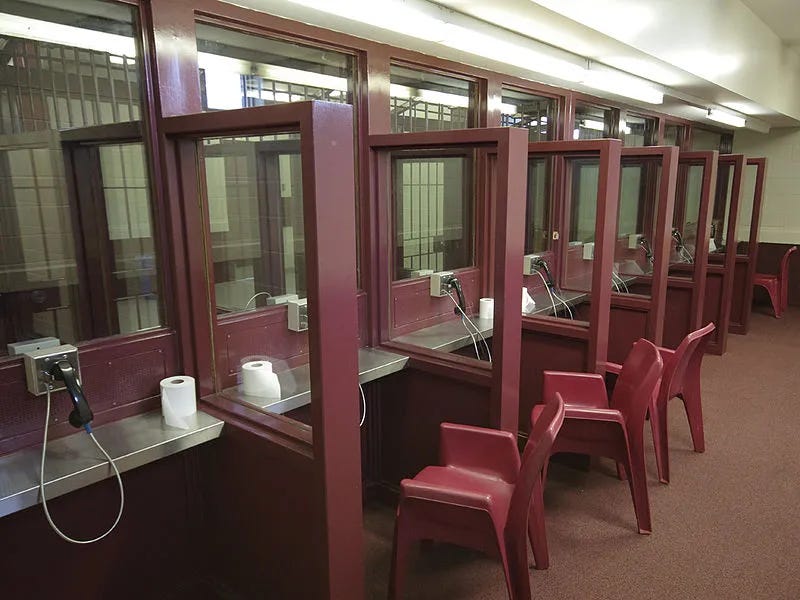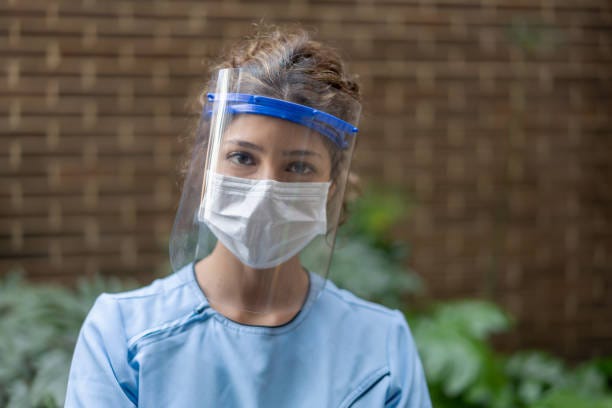"A Death by a Thousand Cuts."
Coronaphobia created ongoing frictions for nursing home visitations, and an everpresent fear that whatever frictions have gone away may be arbitrarily reimposed at any time. This is killing them.
One of the reasons why I exist on Twitter and Substack at all (aside from, as it says in my Twitter bio - to “rant freely”) is to talk about an insider’s perspective on what nursing homes are like as a healthcare worker, but unburdened from the need to protect officially-accepted narratives.
So let’s talk a bit more about nursing homes and visitations.
I’m in a privileged position - I work at a single long-term care facility (I long ago gave up the gig of being a roving consultant) with an office, and a salary. When I started at my facility, years ago, management was in the middle of a push to “transform” the nursing home away from being a “hospital” and instead into a “home.”
A lot of us kind of rolled our eyes at this at the time, doctors, nurses, and social workers alike. It seemed like a lot of aspirational mumbo-jumbo - but all sorts of ideas were shared and some were even implemented.
The saying "This is their home. We are just guests” actually was turned into a placard that was placed in the main lobby entrance of our nursing home, and stood there for many years. This statement (not sure of the origin) came from the “person-centered care” movement and emphasized that nursing homes are in fact *homes* (people live there) and we needed to treat the residents (again, residents - not patients) with dignity and respect.
Some other examples of changes that were proposed, or went further:
They literally discussed taking away the nursing stations in our facility. The idea there was that it “created separation” from our residents and that this was hierarchical, and not “homelike.” Again - I kind of rolled my eyes at this idea originally when I heard it (now, I would welcome it).
Creating “getting to know you” placards where residents pictures and brief bios are posted prominently, so they are more than just patients - they are humanized a bit (we still do this).
They tried getting rid of having unmonitored ‘snack baskets’ at the nursing stations - the thinking being it was “un homelike” and paternalistic to have snacks for our residents controlled and doled about by nursing staff (this was later canned as an idea when some of our residents started hoarding snacks in their rooms - predictable).
A practice at my long-term care facility (which belongs to a nationwide network of facilities) that I had no compunctions about being eliminated was the practice of visiting hours. When I first started at my nursing home - the idea was that families and visitors could only come at certain times (due to staffing available to assist or monitor the visit, or infection concerns, etc). But this was eliminated because again - the nursing home is a HOME and you aren’t supposed to be limited when you can see your close family members!
The Value of Encouraging Family & Friend Visitors at Nursing Homes
Is there any question that social support for nursing home residents is important? I mean, obviously, it makes them feel good, right?
Well. it also looks like that more family and friend visits probably keep nursing home patients living longer.
Holt-Lunstad, Smith, & Baker, et al. (2015) did a meta-analytic study using 70 high quality studies looking at mental health outcomes and found consistently significant results indicating that both subjective and objective indicators of social isolation significantly predict both increased anxiety, depression… and it kills older adult residents.
Another study by Chen and Feeley (2014) looked at how social support, social strain, loneliness, and well-being are related among older adults. They used data from the massive Health and Retirement Study1 to show that having social support is critical for older adults' mental and emotional health.
Interestingly, they also looked at measures of "social strain" as well. It appears that social support (mainly spouse and friend visitors) had a greater overall effect in the positive direction than the contribution of family or friends making too demands on them, criticizing them, or making them feel tense or angry.
In other words - denying older adult residents socially supportive contacts is more harmful to their health than for them to experience ‘socially strained’ relationships. And, denying them access to these positive social supports could kill them.
The Various Historical (and Still Persisting) Frictions on Nursing Home Visitation
So let’s talk about “frictions.”
It’s 2023 currently. We are, thankfully, beyond the era (which lasted several horrific months for us) of prison-like window visits, where residents were forced to meet with their family as if they were incarcerated prisoners - looking through glass and only able to speak to each other by phone.
There was a very significant dropoff in visitor traffic around this time.
Initially, I would say universally (particularly in 2020) the reasons for this was primarily fear. This isn’t a big surprise - due to horrific sounding stories coming from New York City and Italy, and a fairly immediate and strong (if murky) sense that older adults were the most at risk of COVID, people stayed away from nursing homes.
However, soon enough the other “frictions” - which, while justified on the basis of safety clearly qualify as disincentives on visitation - started to stack up:
Temperature checks at the door
PCR testing requirements
“Gate security” with the super-familiar questions we all have memorized by now.2
Visit scheduling - due to the need to have nursing “monitor visits for safety” and requirements to limit # of visitors in the building at any one time, not only did visiting hours come back - but visitors had to pre-schedule visits and clear them with staff (our poor overloaded Social Workers do this).
On again, off-again what I call “snap lockdowns” - over the last three years we’ve had probably a half dozen of these. Often these were the result of simply positive tests amongst nursing staff and/or residents, often with little or no symptoms in our multi-vaxxed, multi-boosted resident and staff population. These “snap lockdowns,” of course, often would unexpectedly cancel previously scheduled visitations
“Show us your papers please” vax mandates, where visitors were required to show proof of vaccination, under what looks now to be a highly overblown premise that the vaccinated can’t transmit the virus to others.
Oh yes, and then there’s this (required of staff, visitors, and residents still at my nursing home):
These Frictions Provide an Ongoing Disincentive to Visitations
While the more extreme “frictions” at nursing homes in the USA have gone away, a number of them remain, particularly masks, temperature checks, visit scheduling, plexiglass barriers, scary capacity limit signs, and masks.
At least, these still remain at my facility - and the threat of “snap lockdowns” remains, along with the re-imposition of any number of other limits on visitation.
The kind of foot traffic we had at our facility pre-2019 is still long gone, and looks like it won’t be returning anytime soon. Yet as far as I can tell, there is zero urgency (yes, an "Urgency of Normal”) in getting our visitors to return to our nursing home or others in the USA like ours - despite the fact that I strongly suspect that we are killing our residents (which appears to be borne out in the literature now coming out3).
Family members, friends, and volunteers are no longer being treated like valued, welcome parts of our long-term care family. They are being treated as basically suspicious irritants and annoyances, to be scheduled out, hassled with masks, temperature checks, and the potential re-imposition of any number of arbitrary measures.
Community visitors are now considered sources of potential infection first, and only peripherally considered providers of something valuable to our residents.
Family, friends, and volunteers are providers of something we used to think of as vital and a first priority for our residents a long time ago in the “before times.” That of love, support, and meaning for our residents.
Such as it is.
References
Holt-Lunstad, J., Smith, T. B., Baker, M., Harris, T., & Stephenson, D. (2015). Loneliness and social isolation as risk factors for mortality: a meta-analytic review. Perspectives on psychological science, 10(2), 227-237.
Chen, Y., & Feeley, T. H. (2014). Social support, social strain, loneliness, and well-being among older adults: An analysis of the Health and Retirement Study. Journal of Social and Personal Relationships, 31(2), 141-161.
The Health and Retirement Study is a large-scale longitudinal study of aging in the United States. It began in 1992 and has collected data from over 37,000 participants as of 2021. The study includes participants who were born between 1931 and 1953 and who were 50 years of age or older at the time of their initial enrollment.
Do you have any symptoms of COVID-19, such as cough, fever, or shortness of breath?
Have you been in close contact with someone who has tested positive for COVID-19 in the past 14 days?
Have you tested positive for COVID-19 in the past 14 days?
Have you traveled internationally in the past 14 days or been in close contact with someone who has?
Have you recently attended a large gathering or been in close contact with someone who has?
A study published in JAMA Network Open in 2020 found a 17.7% increase in mortality among nursing home residents in the United States during the early months of the pandemic compared to the same period in 2019 - and they controlled for COVID-19 infection and other factors (Lewnard et al., 2020). Similarly, a study published in Age and Ageing in 2020 found a 30% increase in mortality among nursing home residents in England during the first wave of the pandemic. While this isn’t straightforward to do statistically, they attempted to control for the effects of COVID-19 infection and other factors (Sze et al., 2020) and it seems lockdowns literally kill nursing home residents.
A study published in the Journal of the American Medical Directors Association in 2021 that found lockdowns were associated with increased depression and anxiety among nursing home residents - and also attempted to control for the effects of COVID-19 infection and other factors (Katz et al., 2021).
Lewnard JA, Liu VX, Jackson ML, et al. Incidence, clinical outcomes, and transmission dynamics of severe coronavirus disease 2019 in California and Washington: prospective cohort study. BMJ. 2020;369:m1923. doi:10.1136/bmj.m1923
Sze S, Pan D, Nevill CR, Gray LJ, Martin CA, Nazareth J, Minhas JS, Divall P, Khunti K, Abrams KR, et al. Ethnicity and clinical outcomes in COVID-19: A systematic review and meta-analysis. EClinicalMedicine. 2020 Oct;29-30:100630. doi: 10.1016/j.eclinm.2020.100630
Katz MJ, et al. Impact of COVID-19 on residents of New York City nursing homes. Journal of the American Medical Directors Association, 22(1), 32-41.
Wang HH, et al. The impact of COVID-19 on weight and nutritional status of older adults in nursing homes. Journal of the American Medical Directors Association, 22(4), 906-907.












I wonder how many old folks died as a result of loneliness and depression during the height of the restrictions? I personally know of a couple who just stopped eating and faded away. The cruelty of some of these policies boggles the mind.
I’m beginning to think that all of this is intentional- by whom I don’t know- to further isolate all of us as human beings. A sort of population control if you will. It’s done under the guise of “protection” when it is anything but. The more isolated we are, the more vulnerable we become and the more controllable we become.